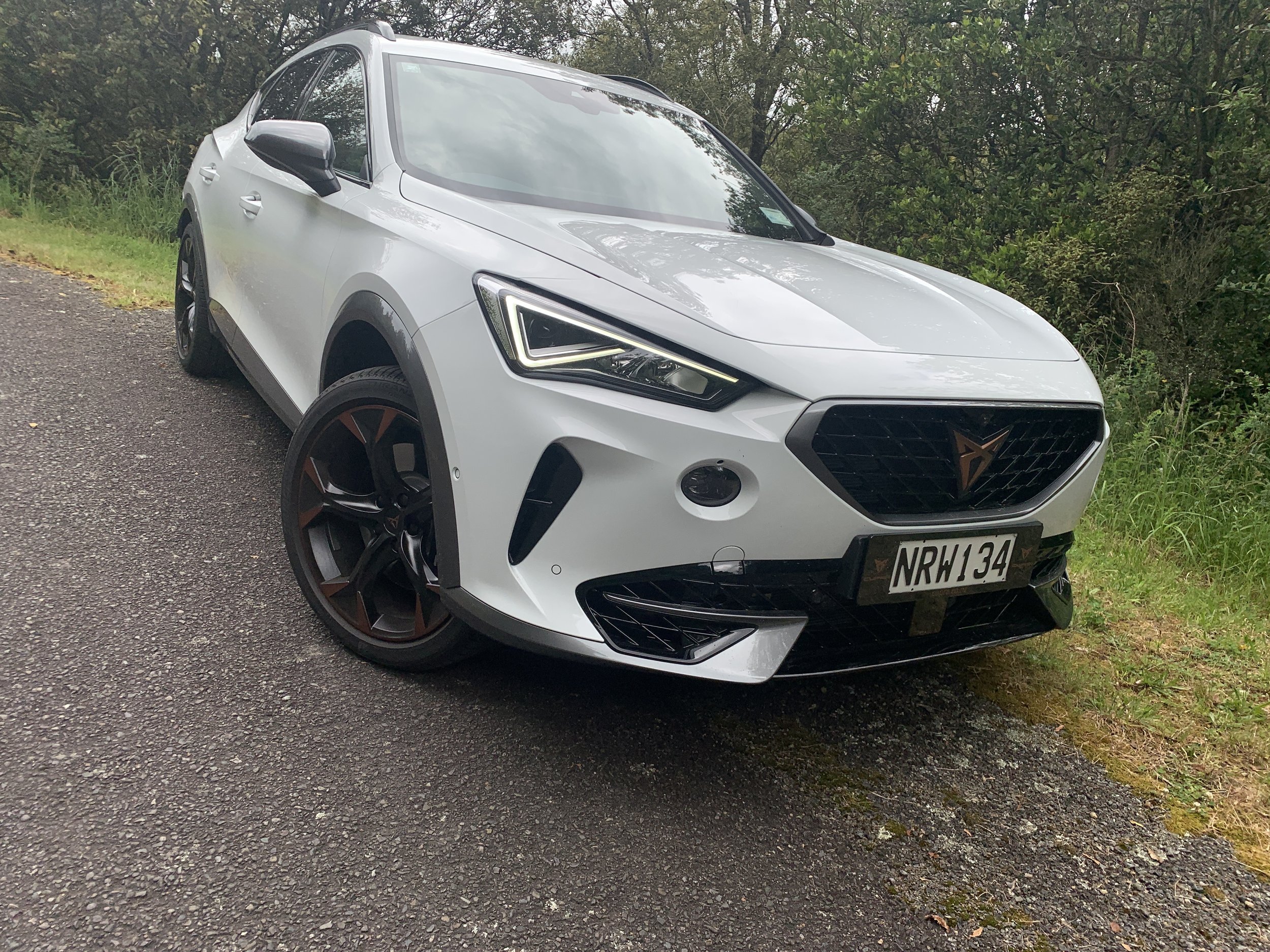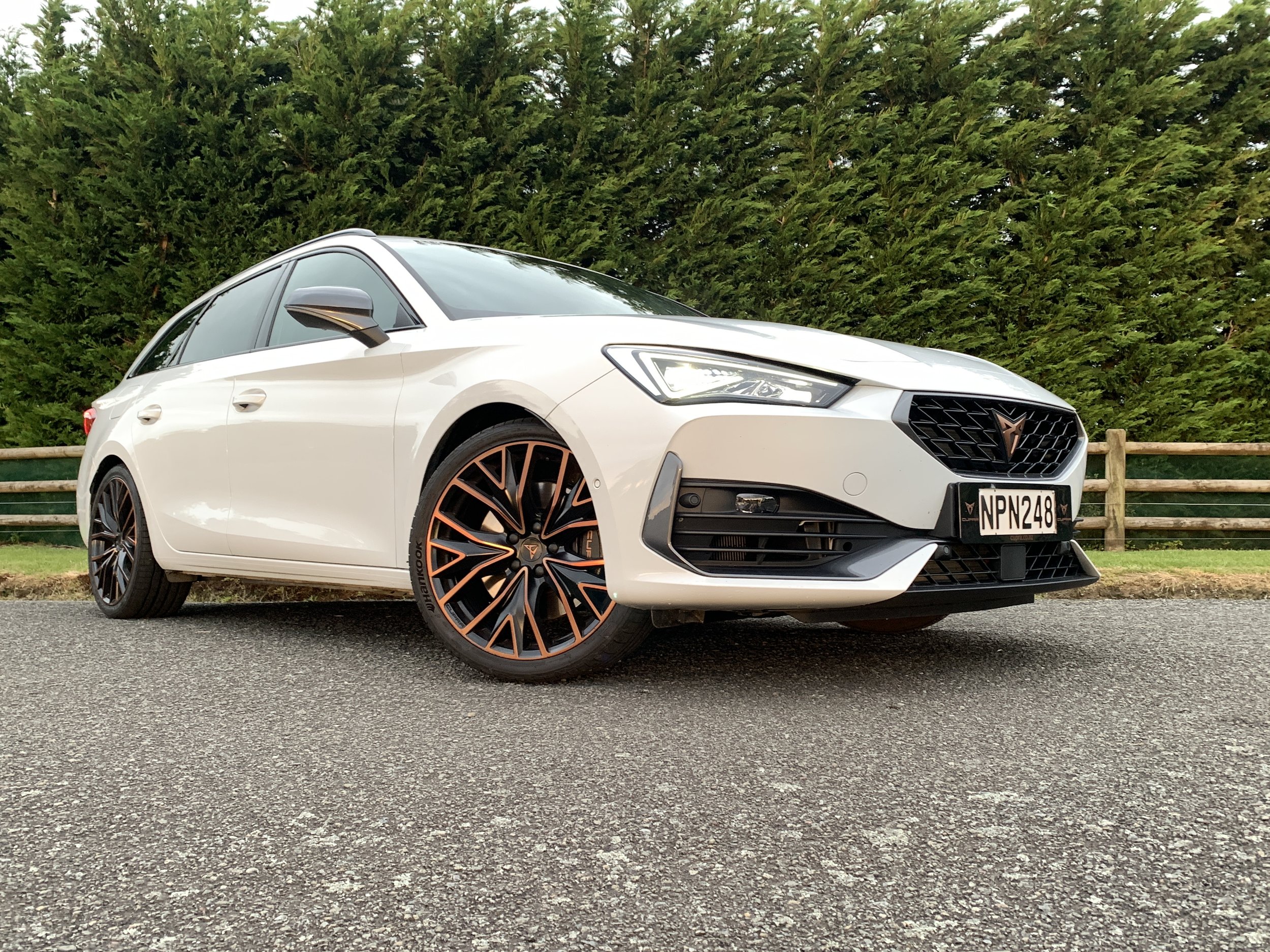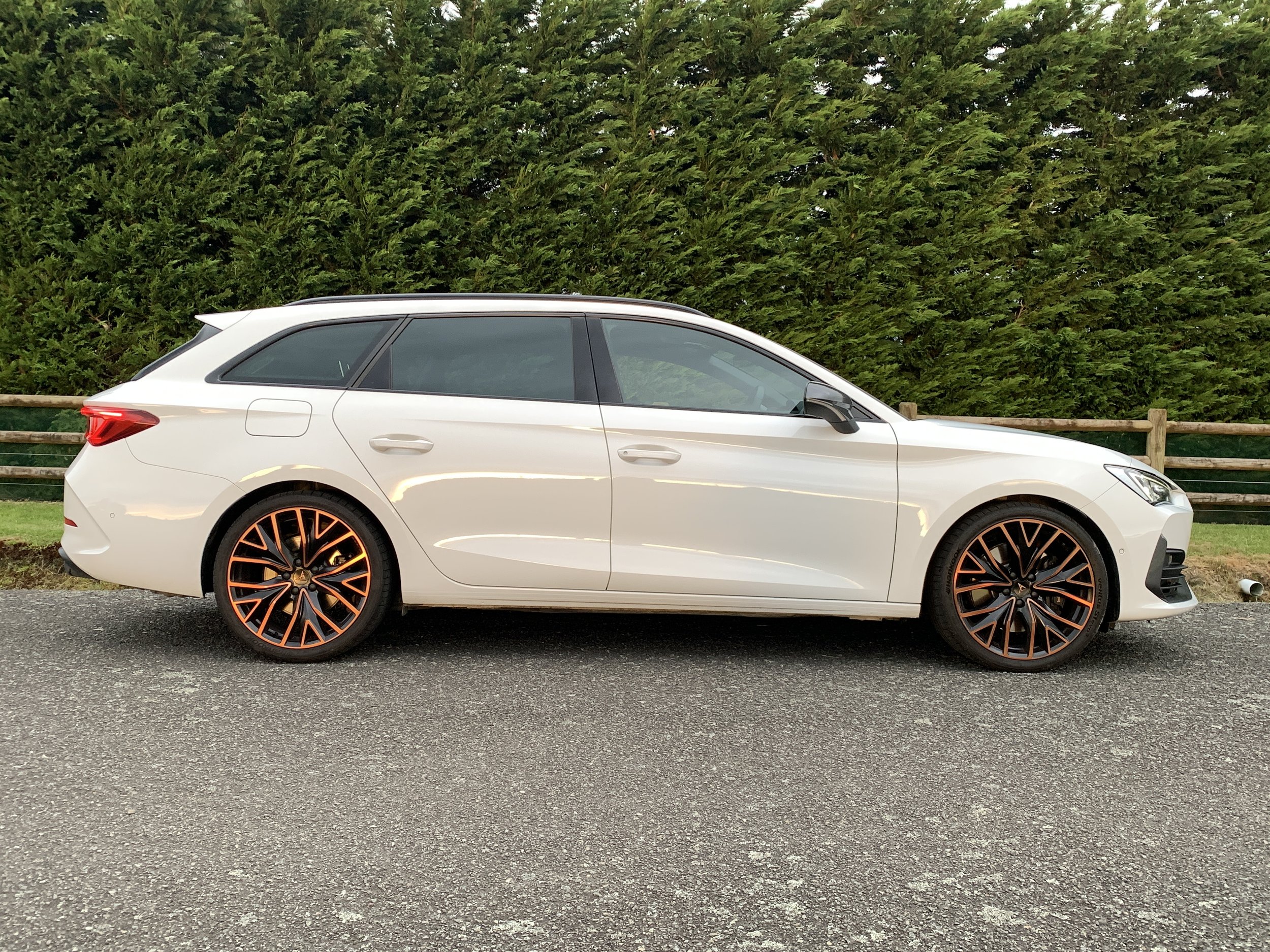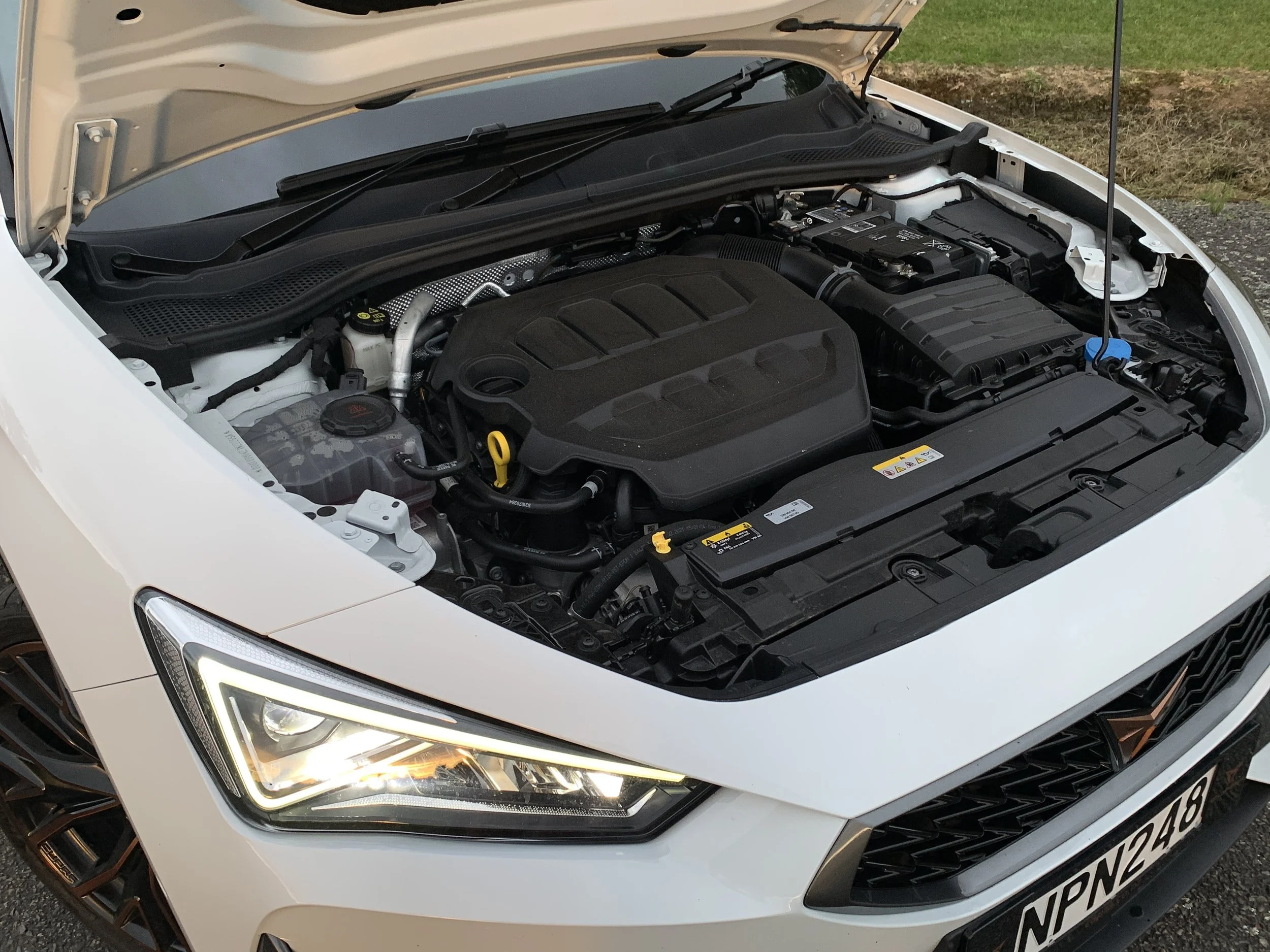Cupra Leon Sportstourer and Formentor VZ review: New age conquistadors
/So you thought all medium VW Group cars were becoming a bit too ‘samey’?
Cupra Formentor (above) and Leon Sportstourer place Golf R hardware into ballistic blue collar settings.
Prices: Leon Sportstourer $65,990 /Formentor $68,900
Powertrain and economy: 2.0-litre turbo-petrol inline four, 221kW (Leon) 228kW (Formentor)/400Nm, 7-speed automatic, AWD, combined economy 6.7 (Leon) 7.7 (Formentor) litres per 100km, CO2 174/177g/km.
Vital statistics: Leon 4657mm long, 1799mm wide, 1437mm high, 2684mm wheelbase, luggage capacity 620/1600 litres; Formentor 4450mm long, 1839mm wide, 1511mm high, 2680mm wheelbase, luggage capacity 345 litres; 19-inch alloy wheels.
Like: Smart-styled, eye-catching top hats on the innards of a Golf R; Formentor’s compact boot.
Don’t like: Work ‘em and they’re drinkers; overwrought badge design.
NO manufacturer group seems so adept at knocking out realistically-priced statement cars than Volkswagen … particularly when those products are devoid of VW badging.
Now is surely the time for the sun to shine brightly on copper-accented Cupra, indisputably the least recognised of the full suite of VW Group holdings represented in New Zealand yet, at the moment, surely the one most worthy of attention, given what it’s now offering.
Cupra in simplest terms is a blue-collar performance hero marque, developing inexpensive versions of Volkswagen's GTI cars. It has been a standalone for four years now, so it is high time to consider it as a fully-fledged brand in its own right? Most certainly, according to Wayne Griffiths, who in addition to being chief executive of this marque also heads the one it was spun from, SEAT.
Griffiths is irritated when Cupra is written up as SEAT’s sub-brand; he argues they are two brands with clear identities under one company, both within the VW Group.
Good argument? Maybe it’s not yet one Kiwis will ‘get’ quite yet. It’s probably best to put all that aside and simply think of Cupra as being rooted in Spain, where the cultural bent is to live life to the fullest.
That ethos truly reflects in the Leon Sportstourer and Formentor. In maxxed VZ spec, these are best-of-breed testosterone-fuelled bulls; standouts in the hot hatch talent pool through being genuinely vibrant, vivacious, well priced and positioned and highly interesting.
That might seem a bold statement, given the DNA. It’s true that those who see Cupra as a high-performance skunkworks of SEAT need understand these cars speak in German dialect. These models share a foundation, drivetrain, electronics and even some switches with the latest Volkswagen Golf. Just as some current Audis and Skodas do.
And, yet, take my word on this; these models are truly very loosely tied by those strings; they’re as different in taste to the VWs – or those other associated makes - as chorizo is to wurst.
A particular appeal of the test models is that they’re fast, stylish and tech-packed five-doors, running the hottest 2.0-litre petrol drivetrain the parent has in stock. Actually, has yet to stock: It’s the turbocharged unit VW itself reserves for the Golf R and Tiguan R, which aren’t here until 2022.
Cupra having nabbed first local market dibs on the engine in almost the same tune – 7kW less power in Formentor (14kW less in Leon) but identical 400Nm torque - and the clever all-wheel-drive and seven-speed direct shift transmission it marries with, along with a full suite of sports modes that enhance the output, ride quality and exhaust resonance is a huge coup. Yes, VW will soon catch up, but for now it’s hasta luega and eat my dust, Germany.
As much as these two Cupras are alike, they’re different. One is fashioned as a low-slung station wagon, the other as a slightly higher-perched, yet still slippery-looking crossover. The price difference is just $3000, Formentor being higher-priced, yet close enough to surely be cross-shopped. Which is a pity: Deciding which is better is a truly tough call.
In my life, the Formentor would probably pip the Leon; I love station wagons and this one fulfils the ‘fun with function’ ideal really well and is also handsome.
Yet the Formentor is just all that and a bit more, still. Even though it is a larger car, it is easily as quick and just as sure-footed. Yes, the boot is a bit smaller, yet it is pretty much as practical. Despite that low-roofed shape, the cabin is just a touch more spacious.
What also fuels Formentor’s attractiveness is the design. Top floor preference for issuing the same products behind different badges, with just enough restyling to suggest individuality, is extremely well disguised here. There’s nothing else in the whole wider family – including even from Porsche and Audi – that delivers in this shape. The Formentor look is so strictly Cupra it won’t even be shared with SEAT.
It’s also the closest thing now to being what SEAT was before being subsumed into VW ownership back in 1986 - a genuinely Spanish product – having been built there (and not all Cupras are) and the designer, Alejandro Mesonero-Romanos Aguilar, is a native (born in Madrid in 1968). He’s now with Renault, but still … if you get hung up on Spanish flair, the one and only Cupra he can be credited with having totally shaped is a great example.
The styling is so bespoke it’s definitely fair to say there’s nothing else in the wider brand family quite like it. If you have to put any kind of tag on it? I guess it’d be a coupe-styled SUV-hatchback. In other words, a bit of everything but a sedan.
Presentation in the metal is a bit different than in images, in that it's lower and smaller than you might expect. Other companies that have tried to design a 'coupe-SUV' could learn from this car. The exterior delivers just the right amounts of ‘mean’ and ‘moody’ and, though quite complex, there’s nothing that jars.
Both models have common signatures of 19-inch wheels, finished in a mixed black-and-copper colour, gloss black trim highlights and copper-finished Cupra badges, which you can expect to hear about. The make proposes them as back-to-back Cs, like a tribal tattoo, but to my eye the graphic is a bit clumsy; kinda like some sort of double-bladed Klingon dagger from Star Trek.
The drama and quirks continues within the cabin. Cupra’s past involvement in motorsport – that’s where the name derives, Cupra being a contraction of ‘cup racer’, created in the days of the Seat Sport division – is celebrated with harness-ready, brilliantly comfy and body-hugging tombstone-backed bucket seats and placement of two buttons on the steering wheel, one to adjust drive modes, the other for the ignition. Just as you’d have it on a competition rally or touring car, but be prepared to help out newbies who might otherwise be at a loss in respect to how to fire up, and shut down, the engine. Spanish style outrage delivers vivid blue leather in the Formentor – a LOT of discussion about that, not wholly favourable - and more agreeable, part leather, part suede charcoal facings for the Leon’s chairs.
There are obviously a number of bits and bobs familiar to all Audi-through-to-Volkswagen customers, such as the diddy gear selector shared with Golf 8, but aside from also sharing a big touch screen, the infotainment layout is way different.
Initially the operability potentially seems a bit more bespoke than it might have needed to be; there’s a lot of swishing into sub-menus. Yet the fact that, after a few days, the logics all seemed to come together with requirement for head-scratching suggests they’re more in tune with a driver’s psyche than might initially seem apparent. In many respects, they are potentially more coherent than VW’s and Audi’s, though maybe not Skoda’s.
Equipment-wise, there’s nothing much different than provisions in any other Group car at this level, so comfort ingredients include a Beats stereo, USB-C charge points and electric-adjusted front seats, electric tailgates, plus there’s the full sweep of safety features.
The Leon has a bigger boot and it’s more practical, with a floor that can be dropped to enhance capacity, but Formentor’s 420-litre space is far from being impractical. The rear seats in both cars are accommodating even for the tall. One weirdness is exposed when the driver’s seat is put back for a tall driver; that exposes a black box, seemingly packed with electronics. What’s it for? Not too sure. I guess it wouldn’t be so easily spotted in left-hand drove versions.
If you really want me to name the cars’ absolute best bit, though, it's the engine. VZ is shorthand for the Spanish word ‘veloz’, meaning fast; a fair call since it’s packing the EA888 engine. Here it represents as an utter firebrand with heaps of gusto and no shortage of character, it’s the sort of powertrain we’re going to miss once the electric age gets up to speed.
The combo of a decent turbo and the DSG dual-clutch automatic gearbox means that there's a touch of lag when slapping down on the throttle, but performance is never less than exciting. That it has two performance settings says much.
Sport is pretty decent but the ultimate Cupra setting is akin to knocking back a glass of neat spirits; there’s utterly full-blown vamoose from the engine, with not just the brassiest exhaust timbre but over-run pops and bangs to egg you on, and the steering, throttle and suspension responses sharpen considerably.
The claimed 0-100kmh times of a smidge under five seconds are decent, so too the 250kmh top speeds, but the appeal is these are cars that feel quicker than the data relates.
Sure, you do pay a price in fuel economy and also emissions - the cited optimals of nine litres per 100km are not easily achieved and a CO2 output of 203g/km means it will suffer ute tax – but it’s just par for this course.
The 4Drive all-wheel-drive system means that traction is never an issue. Formentor differs from Leon in being meted off-road mode, which seems utterly unnecessary, given it’s not at all dressed for that kind of thing; not much ground clearance it has performance tyres. The sports driving modes are great in both models, though you do pay a cost with a tuff ride and some tyres roar. When occupants are aboard it’ll be understandable for comfort to become the go-to; the ride quality is just better cushioned, though not fantastically. That setting is more effective in quietening down the engine noise, though it’s just not a powerplant that whispers. Doubtless some artificial enhancement occurs here , but that the cars sound awesome to bystanders when they depart the scene, suggests the core sound is truly real.
SUV-styled cars are always intriguing propositions as performance fare, but arguably Formentor escapes any judgement because, even it has something of the look, in scale it’s more akin to being a scaled up hatchback. For all that, if the two were run together, the Leon would be the sharper-witted, with Formentor’s handling being more limited by its height and weight. But I really thing it’d be a close run thing. In isolation, Formentor really does execute its go-fast duty with a high degree of diligence; there’s not much more body roll than with the Leon and it generally feels well-connected and committed, with good steering feel, excellent balance and fantastic grip. Both cars also have very good brakes.
It never hurts to have cars that will draw interest; these models certainly do that. They each provoke conversation, which bodes well for a brand that, let’s face it, still isn’t much of a talking point with even enthusiasts.
What’s also attractive is that, regardless that the drivetrain and platform are highly performance-fixated, these models are not so uncouth as to alienate them as family transport. That, and the genuinely strong pricing advantage over the donor models, makes these top dogs really worthy of close consideration.
Definitely the best of formula Juan.




























